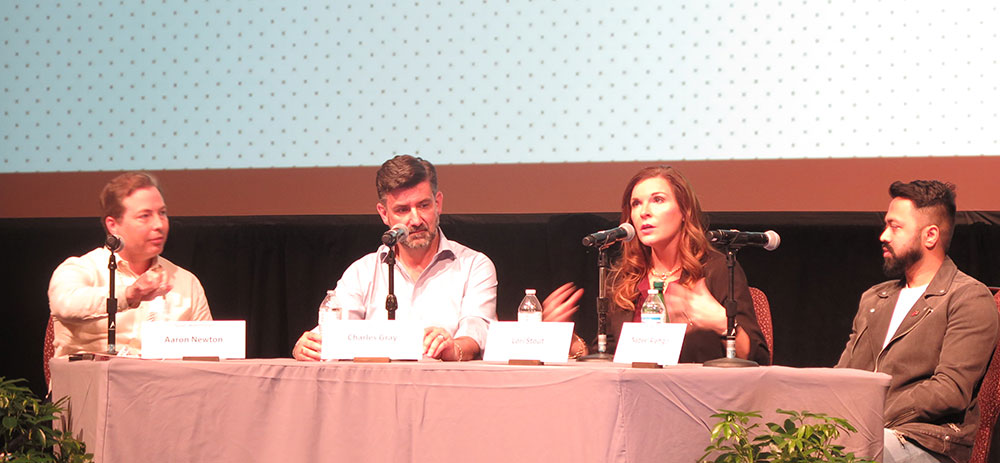During a panel May 4 at the Food On Demand Conference in Las Vegas, loyalty and customer engagement platform providers discuss the importance of creating offers that show restaurants know their guests. From left, Aaron Newton, chief product officer, Thanx; Charles Gray, chief revenue officer, Paytronix; Lori Stout, VP of marketing, Punchh/PAR Technology; and Nabeel Alamgir, founder and CEO, Lunchbox.
Along a restaurant’s relationship continuum with a customer, the discount is “like a one-night stand, it’s a transaction,” and on the other end is loyalty, which requires “emotional affinity.” So said Fred LeFranc, CEO of Results thru Strategy, as he opened up a panel today at the fifth annual Food On Demand Conference all about monetizing brand loyalty.
“How does Chick-fil-A have an $8 million AUV when they’re only open six days a week?” said LeFranc in reference to Chick-fil-A’s average unit volumes for freestanding locations, which reached a record $8.1 million per store in 2021. Because they “elicit an emotional response.”
An emotional connection is what the companies represented on the panel aim to help restaurants achieve with their customers, and much of it relies on data collection.
“We always say, just the borderline of creepy,” said Charles Gray, chief revenue officer at Paytronix, a customer engagement tool and loyalty provider. Customers, he continued, want to feel as though the brands they interact with know them, which means the messaging can’t be generic.
To Lori Stout, VP of marketing at Punchh/PAR Technology, that means not sending an offer to try a new burger to a customer who’s only ordered plant-based items. Punchh’s technology can tag items on a receipt and feed that information to the restaurant.
“If I put on my consumer hat, I want to be creeped out by the brands that I use … I love to be treated like a VIP when I shop with restaurants and I love that they know me,” she said.
At the same time, restaurants must differentiate themselves in an increasingly crowded food industry of third-party delivery services, virtual brands, ghost kitchens and more.
“If you want to compete with a third-party platform in a digital relationship with the guest, you can’t just have it be a race to the bottom on margin against the DashPass,” said Aaron Newton, chief product officer at marketing and loyalty firm Thanx, in a reference to DoorDash’s subscription service. Instead, restaurants must create and offer something different, such as access to hidden menus only for certain customers.
“They aren’t discount-oriented, they’re privileges for being a guest,” he said.
Ownership of the customer relationship—and customer data—is something many restaurants are trying to wrestle back from third-party platforms as they aim to push transactions to their own websites and apps, drive loyalty program engagement and establish native delivery programs.
“As I see it, awhile ago the restaurant industry didn’t get ahead of a consumer trend that was coming and created an opportunity for someone to step in and disrupt the space by saying, you won’t spend the money on technology, we will,” said Newton. “It’s time for all the restaurants out there to decide how important it is to own this relationship.”
A lack of investment in owning the customer has cost restaurants “way more than that 30 percent” they would pay in delivery commissions, Newton asserted as he encouraged operators in the audience to build their own user experience.
“When you make that order you have to capture that customer’s identity—no guest checkout crap,” he said. “And that whole cycle has to create affinity with them that turns into habit. And you cannot do that on a third-party marketplace.”
For Nabeel Alamgir, founder and CEO of Lunchbox, a platform offering online ordering, integrations and marketing for restaurants, he wants to “help build the digital storefront of the future.” Doing that, he said, means partnering with restaurant brands that have a story to tell and helping them tell it. “And not all brands have a story to tell and not all brands have food that deserves loyalty,” he noted. The aim is to be “a little bit more thoughtful about how we connect restaurateurs with their guests.”
Lunchbox today launched Lunchbox Rails, a new all-in-one integrations system for managing third-party online ordering. Rails consolidates third-party marketplace orders and pulls the order information into a restaurant’s point-of-sale system.
The fifth annual Food On Demand Conference continues May 4-6 at the Mirage in Las Vegas.


